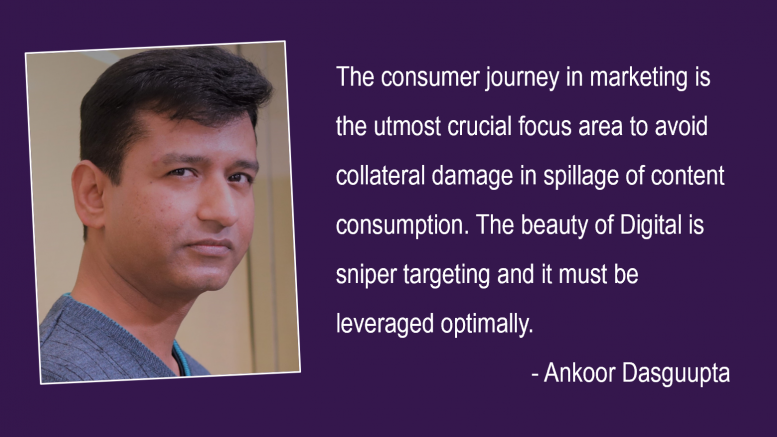The Indian population has taken to social media like how and on average, spend about 2.36 hours on social media daily. In India, the number of social media users have been growing in 2023 at a steady rate of 467 million due to deep penetration of internet connectivity among people. The number of Internet users in India has grown to a whopping 692 million (and growing) which is roughly 48.7% of the total population of India.
The consumer journey in marketing is the utmost crucial focus area to avoid collateral damage in spillage of content consumption. The beauty of Digital is sniper targeting and it must be leveraged optimally. The exercise I start with is understanding the Brand Key and mapping that against the key competition. Arriving at the competition is important as the thinking exercise must consider at least 2 players who are not head-on in business though may be head-on in terms of the product attributes and brand ethos.
As a marketing practitioner, I do not think consumers understand Brand marketing or Performance marketing. They understand narratives in the moments that matter to them.
My inner child keeps poking me – Why can’t Brand Marketing be performance Marketing in holistic terms? Will our approach to marketing change if we treat these 2 as part of one initiative? If yes, then what is there to lose? Are Performance Marketing experts be Brand Experts as well? If not then what is stopping? Are we embracing the interplay of performance and brand marketing and then look at both – the nuanced view and the panoramic view with respect to ROI?
Here are top 4 things that brands must focus on before looking at the ROI math –
- Brand Key
Think of the Brand Key as an actual Key Shape where we list down 3 part of the tip, cuts and shoulder –
- Competition – direct and indirect – the market & alternative choices as seen by the consumer.
- Target – person for which the brand is the best choice in terms of attitudes & values (not just demographics)
- Insight – all we know about the target consumer and their behaviour, needs.
Then the bow/ circle of the key, imagine it like –
- Centre position – Essence which is Brand’s DNA into one clear thought and goal
Surrounded by –
- Values & Personality – what the brand stands for and believes in
- Discriminator – the single most compelling reason for the target consumer to choose the brand
- Benefits – functional and emotional aspects
- Reason to Believe – which is the proof we offer to substantiate the positioning.
- Purpose
From the Brand Key exercise, we will automatically arrive at our Purpose which will pave the way to purpose driven marketing. For example, globally today, consumers are seen to be more inclined towards brands that have sustainability as a piece in their purpose.
- Moments that Matter
Arriving at the third point, it is important to reach the consumer in the moments that actually matter to ‘them’ and I am not talking about a moment-marketing post. Learning to differentiate between posts and campaigns is important if we think of storytelling in its essence so that he marketing initiatives are sustainable in nature. This also means to contextualise the customer experience as at the end what churns the flywheel to bring in strangers to become advocates? The answer is ‘the experience with the brand’ at the specific touchpoint and moment. The beauty is in making simple attempts at the complex consumer journey. To crispy-fy , just think of the ‘Moments’ google came out with few years back –
- I want to know Moments – when someone is exploring but not necessarily in purchase mode
- I want to go moments – when someone is considering buying from a nearby store or online
- I want to do moments – when someone wants help completing a task or to try something new
- I want to buy moments – when someone is ready to make the purchase & may need help deciding
- Think of Data as to what is it solving for longer run
Think of the customers who use coupons or customers who browse online but only purchase at a store. By integrating the online and offline customer journey with data, businesses can attribute sales and conversions with more accuracy. This improves the understanding of which online efforts drive in-store purchases and vice versa. Ultimately, this allows for transparency into how resources could be better allocated to maximise business profitability and better ROI. Moreover, I observe quite a few marketers continue to over-index the last point in the consumer journey before purchase. This is an assumption that may need to be challenged. Research from TikTok and AppsFlyer reveals that up to 58% of users delay visits to brand websites and apps as they do not want to disrupt their viewing experience.
To revisit, think of all the above before arriving at the question ‘what should be the ROI’ and think of making it easier for the consume to ‘consume’ your content as content is the pedestal that creates experiences.
As an ending note, sharing below is a representation I was reading in a report by BCG, and it showcases the complexity of the non-linear consumer journey today :-

The views and opinions published here belong to the author and do not necessarily reflect the views and opinions of the publisher.



Be the first to comment on "Arriving at a credible ROI for Brands"